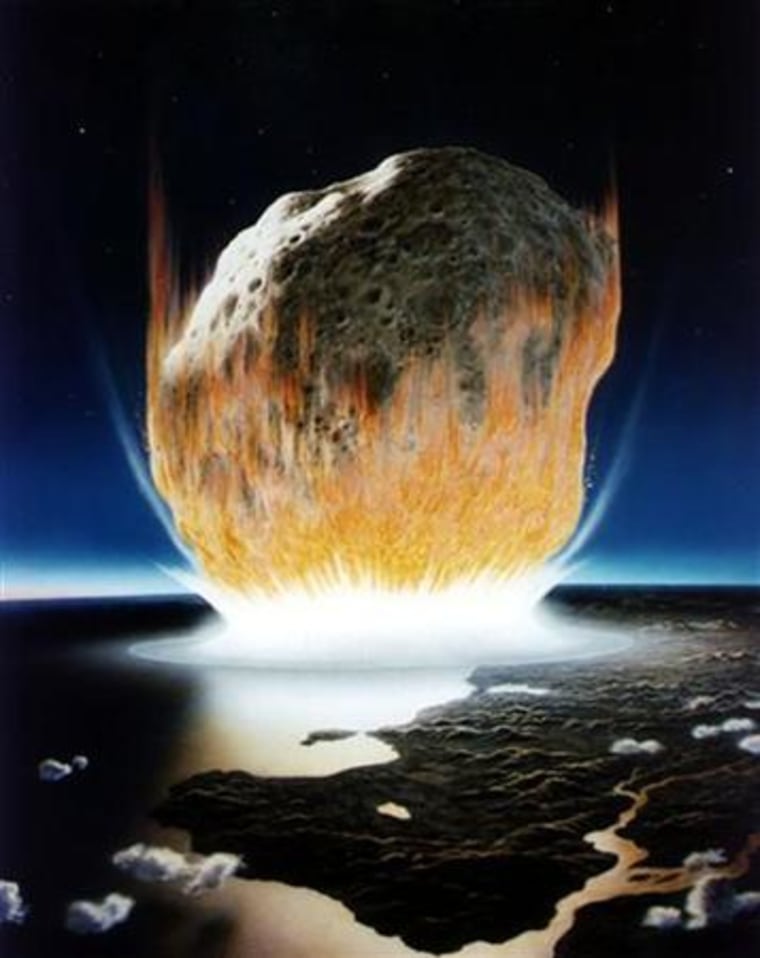The United States must do more to safeguard Earth against destruction by an asteroid than merely prepping nuclear missiles, a new report has found.
The 134-page report, released Friday by the National Academy of Sciences, states that the $4 million spent by the United States annually to identify all potentially dangerous asteroids near Earth is not enough to do the job mandated by Congress in 2005.
NASA is in dire need of more funding to meet the challenge, and less than $1 million is currently set aside to research ways to counter space rocks that do endanger the Earth — measures like developing the spacecraft and technology to deflect incoming asteroids — the report states.
An early draft of the report, entitled "Defending the Earth: Near-Earth Object Surveys and Hazard-Mitigation Strategies," was released in August 2009. The final report, written by a committee of expert scientists, says NASA is ill-equipped to catalog 90 percent of the nearby asteroids that are 460 feet (140 meters)across or larger, as directed by Congress.
The United States should also be planning more methods of defending Earth against an asteroid threat in the near-term. Nuclear weapons should be a last resort — but they're also only useful if the world has years of advance notice of a large, incoming space rock, the report states.
Likewise, decades of notice are required to build and launch spacecraft to push an asteroid clear of Earth or smash it with a forceful but non-nuclear, projectile, the committee wrote in the report. Organized evacuations and other civil defense efforts would only be useful in the event a smaller threatening object is found with limited advance notice, it added.
NASA's asteroid and near-Earth object experts say the agency has found about 85 percent of the largest nearby asteroids, ones that are a half-mile (1 kilometer) wide or larger. But only 15 percent of the 460-foot-wide asteroids near Earth have been discovered and tracked to date, and just 5 percent of nearby space rocks about 164 feet (50 meters) across have been found.
No extra funding set aside
Lindley Johnson, NASA's manager of the Near-Earth Objects Program, has said that NASA needs up to $1 billion in additional funding over the next 15 years in order to meet its goal of finding all nearby asteroids that could threaten Earth.
But neither President Barack Obama's administration, nor that of former President George W. Bush, has set aside extra funding to support near-Earth object surveys, according to the report.
Recent meteor bursts over the United States have also highlighted the potential danger of even smaller asteroids, so NASA should also try to find as many of those objects — which range between 30 and 50 meters in size — as possible, the report's committee found.
Even small space rocks pose a threat to people and property on Earth.
On Monday, a small, half-pound meteorite crashed through the roof of a doctor's office in Virginia, punched through a wall and upper floor before slamming into pieces when it hit a concrete floor at a speed that may have hit 200 mph. No injuries were reported, but the doctor's office was populated at the time.
Cosmic insurance policy
According to the report, current long-term projections estimate that there could be up to 100 fatalities a year caused by space rock impacts, though admittedly the chances of such rare hits are remote.
Still, "this presents the classic problem of the conflict between extremely important and extremely rare," the report stated. "The committee considers work on this problem as insurance, with the premiums devoted wholly towards preventing the tragedy."
Among the panel's conclusions and recommendations:
- At current levels of funding, it is not possible for NASA to catalog all asteroids wider than 460 feet by the year 2020, as Congress mandated.
- If Congress takes the view that cataloging such asteroids is a high-priority, the best course would be to fund a space telescope as well as ground-based telescopes to do the job, conceivably by 2022.
- If the priority is considered lower, ground-based telescopes could conceivably accomplish the task well before 2030. The panel said one of the best telescopes for this kind of work is the Large Synoptic Survey Telescope, which is due to begin operation in 2014.
- Federal funding for the Arecibo Observatory in Puerto Rico should continue in order to characterize the orbits of near-Earth asteroids. Efforts to keep Arecibo funded have faced resistance in recent years.
- International cooperation should be pursued to counter the asteroid threat.
This report was supplemented by msnbc.com.
